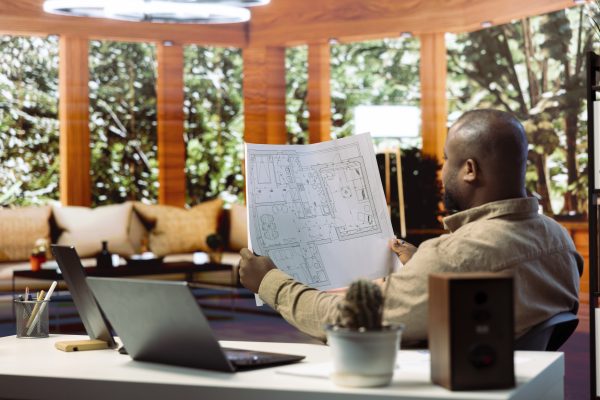According to the 2021 AIA Compensation Report, 72% of architecture firms offered full-time or nearly full-time remote work options to employees in 2020. This shift reflects the growing prevalence of remote work in the industry, especially as firms tackle large-scale projects that require collaboration across multiple locations. Remote architects, once a rarity, have now become integral members of project teams, bringing their expertise from around the world. However, managing these large-scale projects remotely introduces unique challenges, such as communication barriers, time zone differences, and the need for seamless collaboration. To overcome these hurdles and ensure project success, it’s crucial to implement workflow strategies for remote architects specifically designed to meet the demands of remote architects working on complex projects.
In this blog, we will explore key workflow strategies that can help remote architects excel in large-scale projects, ensuring that these projects are completed efficiently, on time, and to the highest standards.
6 Workflow Strategies for Remote Architects on Large-Scale Projects

-
Establish Clear Communication Channels
Effective communication is the backbone of any successful project, and this is especially true for large-scale projects involving remote architects. With team members spread across various locations, it’s crucial to establish clear and reliable communication channels from the outset.
Utilize Collaboration Tools
Invest in collaboration tools like Slack, Microsoft Teams, or Zoom to facilitate real-time communication. These platforms offer chat functions, video conferencing, and file-sharing capabilities, making it easier for remote architects to stay connected with the team and contribute to discussions as they happen.
Set Regular Check-ins
Schedule regular check-ins or stand-up meetings to keep everyone on the same page. These meetings can be brief but should focus on updates, addressing any issues, and ensuring that everyone is aligned on project goals. Depending on the project’s complexity, these check-ins might be daily, weekly, or bi-weekly.
Create a Centralized Communication Hub
Establish a central location where all project communications, documents, and updates are stored and accessible to everyone involved. This could be a project management tool like Asana, Trello, or Basecamp, where tasks can be assigned, deadlines tracked, and files easily accessed.
At BizForce, our architects excel in remote collaboration, ensuring that communication remains seamless no matter where the team is located. We prioritize the use of cutting-edge collaboration tools and platforms that facilitate real-time interaction and efficient information sharing. Our architects are not only skilled in their craft but also adept at navigating the complexities of remote work, ensuring that every detail is communicated clearly and effectively. By partnering with BizForce, you can trust that our remote architects will maintain the high level of communication necessary to keep your large-scale projects on track and aligned with your vision.
-
Leverage Advanced Project Management Tools
Large-scale projects involve numerous tasks, deadlines, and team members. Managing these components remotely requires a robust project management system that can handle the complexities of the project while keeping everyone on track.
Task Management
Use advanced project management tools such as Monday.com, Wrike, or Jira to break down the project into manageable tasks. Assign tasks to specific team members, set deadlines, and track progress in real-time. These tools also offer visual dashboards that provide a clear overview of the project’s status, helping remote architects understand where their contributions fit into the larger picture.
Document Management
Implement a cloud-based document management system like Google Drive, Dropbox, or OneDrive to store all project-related files. Ensure that all team members have access to the latest versions of drawings, plans, and specifications, and that any changes are tracked and communicated promptly.
Time Tracking
For remote architects, managing time efficiently is crucial, especially when working across different time zones. Time-tracking tools like Toggl, Harvest, or Time Doctor can help architects log their hours, ensuring transparency and allowing project managers to monitor productivity and project timelines.
-
Foster a Collaborative Culture
Collaboration is key to the success of large-scale projects, and fostering a collaborative culture among remote architects is essential. Despite the physical distance, it’s possible to create a sense of teamwork and shared purpose.

Encourage Open Communication
Promote an environment where remote architects feel comfortable sharing ideas, asking questions, and providing feedback. Open communication leads to better problem-solving and innovation, which are critical on large-scale projects.
Organize Virtual Workshops
Virtual workshops or brainstorming sessions can bring the team together to collaborate on design challenges, explore new ideas, and refine project plans. These sessions can also serve as team-building exercises, helping remote architects feel more connected to their colleagues.
Recognize and Celebrate Achievements
Celebrate milestones and achievements, no matter how small. Recognizing the hard work of remote architects helps build morale and reinforces a sense of belonging within the team. This can be done through shout-outs in meetings, emails, or even virtual celebration events.
-
Implement a Strong Version Control System
In large-scale projects, multiple architects may be working on different aspects of the design simultaneously. Without a strong version control system, this can lead to confusion, errors, and delays.
Use Version Control Software
Implement version control software like Git or a cloud-based system that tracks changes made to documents, drawings, and models. This ensures that everyone is working with the most up-to-date files and that any revisions are properly documented.
Standardize File Naming Conventions
Establish standardized file naming conventions that all team members must follow. This minimizes the risk of confusion and makes it easier to locate specific documents quickly.
Regularly Update and Backup Files
Ensure that all project files are regularly updated and backed up. This prevents data loss and ensures that remote architects can continue working without interruption, even in the event of a technical issue.
-
Optimize Workflow for Different Time Zones
One of the challenges of managing a team of remote architects is coordinating work across different time zones. However, with careful planning, time zone differences can be turned into an advantage.
Stagger Work Hours
If possible, stagger work hours to create overlapping time slots where team members in different time zones can collaborate in real-time. This overlap is particularly useful for meetings, brainstorming sessions, and urgent tasks.
Implement a “Follow the Sun” Model
For projects that require 24/7 progress, consider implementing a “follow the sun” model where work is passed between team members in different time zones. This approach ensures that the project moves forward continuously, reducing downtime and speeding up completion.
Use Time Zone Tools
Tools like World Time Buddy or Time Zone Converter can help team members quickly identify overlapping work hours and schedule meetings that accommodate everyone’s availability.
-
Ensure Compliance with Local Regulations
Large-scale projects often span multiple jurisdictions, each with its own set of regulations and building codes. Remote architects must be vigilant in ensuring that their designs comply with local requirements.
Stay Informed
Remote architects should stay informed about the local regulations and building codes relevant to the project’s location. This may involve conducting research, consulting with local experts, or attending relevant training.
Collaborate with Local Partners
Partnering with local consultants can provide valuable insights into local regulations and help ensure compliance. These local partners can also assist with obtaining necessary permits and approvals.
Document Compliance Efforts
Keep detailed records of all compliance-related research, consultations, and decisions. This documentation is essential for demonstrating due diligence and can be invaluable if any compliance issues arise.
Conclusion
Managing large-scale projects with remote architects requires a strategic approach to workflow that emphasizes communication, collaboration, and adaptability. By establishing clear communication channels, leveraging advanced project management tools, fostering a collaborative culture, implementing strong version control, optimizing for different time zones, and ensuring compliance with local regulations, remote architects can contribute effectively to large-scale projects.
These workflow strategies for remote architects not only help overcome the challenges associated with remote work but also enhance the overall efficiency and success of large-scale architectural projects. As the architecture industry continues to embrace remote work, mastering these strategies will be key to staying competitive and delivering exceptional results.
BizForce’s Workflow Strategies For Remote Architects Will Help Your Firm Excel in Large-Scale Projects
Ready to take your large-scale architectural projects to the next level? Partner with BizForce and leverage our team of expert remote architects who excel in strategic workflow management. From seamless communication and collaboration to cutting-edge project management tools and compliance expertise, BizForce architects are equipped to handle the complexities of your projects. Don’t let distance be a barrier—let BizForce bring your vision to life with efficiency and precision. Contact us today to learn how we can support your next big project. Click here.
